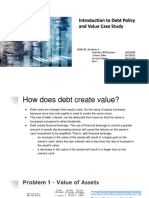0 ratings0% found this document useful (0 votes)
134 viewsM&A Valuation
M&A Valuation
Uploaded by
mithunsworldThis document discusses three common approaches to valuation in mergers and acquisitions (M&A) transactions: the asset-based approach, income-based approach, and market-based approach. The asset-based approach values a company's individual assets, while the income-based approach calculates the net present value of future income streams using discount rates. The market-based approach compares financial metrics of the target company to similar metrics of comparable companies that have established market values. Selecting the most appropriate valuation approach depends on the specific circumstances and nature of the target company.
Copyright:
© All Rights Reserved
Available Formats
Download as DOCX, PDF, TXT or read online from Scribd
M&A Valuation
M&A Valuation
Uploaded by
mithunsworld0 ratings0% found this document useful (0 votes)
134 views7 pagesThis document discusses three common approaches to valuation in mergers and acquisitions (M&A) transactions: the asset-based approach, income-based approach, and market-based approach. The asset-based approach values a company's individual assets, while the income-based approach calculates the net present value of future income streams using discount rates. The market-based approach compares financial metrics of the target company to similar metrics of comparable companies that have established market values. Selecting the most appropriate valuation approach depends on the specific circumstances and nature of the target company.
Original Description:
M& A valuation
Copyright
© © All Rights Reserved
Available Formats
DOCX, PDF, TXT or read online from Scribd
Share this document
Did you find this document useful?
Is this content inappropriate?
This document discusses three common approaches to valuation in mergers and acquisitions (M&A) transactions: the asset-based approach, income-based approach, and market-based approach. The asset-based approach values a company's individual assets, while the income-based approach calculates the net present value of future income streams using discount rates. The market-based approach compares financial metrics of the target company to similar metrics of comparable companies that have established market values. Selecting the most appropriate valuation approach depends on the specific circumstances and nature of the target company.
Copyright:
© All Rights Reserved
Available Formats
Download as DOCX, PDF, TXT or read online from Scribd
Download as docx, pdf, or txt
0 ratings0% found this document useful (0 votes)
134 views7 pagesM&A Valuation
M&A Valuation
Uploaded by
mithunsworldThis document discusses three common approaches to valuation in mergers and acquisitions (M&A) transactions: the asset-based approach, income-based approach, and market-based approach. The asset-based approach values a company's individual assets, while the income-based approach calculates the net present value of future income streams using discount rates. The market-based approach compares financial metrics of the target company to similar metrics of comparable companies that have established market values. Selecting the most appropriate valuation approach depends on the specific circumstances and nature of the target company.
Copyright:
© All Rights Reserved
Available Formats
Download as DOCX, PDF, TXT or read online from Scribd
Download as docx, pdf, or txt
You are on page 1of 7
Valuation Basics in M&A Transactions
A common refrain is that valuing a company is as much an art as it is a
science. There are a number of valuation rules of thumb but there are
exceptions to each of these rules. Beauty may be in the eye of the
beholder, but the ultimate value of a company in an M&A transaction is
determined as that value upon which a willing buyer and a willing
seller finally agree and conclude the transaction.
This article discusses three commonly used approaches to valuation:
the asset-based approach, the income-based approach, and the
market-based approach. Although the market-based approach may be
the more common approach in an M&A transaction, each approach
may be more or less appropriate depending on the circumstances.
Initially, however, it is important to understand the difference between
valuing a company being acquired in the form of an asset purchase
transaction as compared to valuing a company being acquired in the
form of a merger or a stock purchase transaction. In a typical asset
purchase transaction, a buyer may acquire all of the seller's assets but
none of the seller's liabilities. In a merger or stock purchase
transaction, a buyer acquires the seller subject to its liabilities.
Assume, for example, a company has earnings before interest and
taxes (EBIT) of $ I million and its sole liability is $ I million in debt. If a
buyer is willing to pay 3x EBIT ($3 million) to acquire this company in a
transaction structured as an asset purchase and will not assume the
debt, the seller will receive $3 million, remain liable to pay off the $ I
million debt and have $2 million left when the debt is paid. However, if
the acquisition is structured as a merger or a stock purchase
transaction, that same buyer may be willing to pay 2x EBIT ($2 million)
since the buyer will acquire the seller subject to the $ I million debt.
More commonly, however, a buyer would not likely consider debt on a
balance sheet to constitute the seller's sole and exclusive liability (e.g.,
there may be any number of potential liabilities such as for
environmental damage, product liability claims, claims related to the
company's relationships and dealings with its employees, suppliers,
customers, investors, etc.) and a buyer may be willing to pay less than
2x EBIT for this company to offset the risks of such potential liabilities
if the acquisition is structured as a merger or a stock purchase
transaction.
Asset-Based Approach
An asset-based valuation approach is commonly used when a
business has a very low or negative value as a going concern. For
example, consider the value of an airline company that has few routes,
high labor and other operating costs, and is losing millions of dollars
each year. Using the other valuation approaches discussed below, the
company may have a negative value. However, to one or more of the
company's existing competitors, the company's routes, landing rights,
leases of airport facilities, and its ground equipment and airplanes may
have substantial value. An asset-based approach to valuing this
company would value the company's assets separately and aside from
the money-losing business in which they are presently being utilized.
The asset-based valuation approach will typically result in the lowest
valuation of the three approaches for a profitable company, but it
nevertheless may result in an appropriate value depending on the
circumstances.
Additionally, the asset-based valuation approach may be appropriate
to use in conjunction with one of the other valuation approaches. For
example, assume a company has a one-location retail business and it
owns the real property and building in which the business operates. If
the company has EBIT of $ 100,000 and a buyer is willing to pay 3x
EBIT for a similar retail business which leases its operating facilities,
the buyer might value this company by adjusting EBIT downwards for
the cost the buyer would have to pay if it were to lease comparable
facilities, and adjusting the company's valuation upward for the value
of the real property and building assets. If the buyer would have to pay
$24,000 per year to lease similar property and could sell the real
property and building for $500,000, the buyer might value this
company at 3x adjusted EBIT plus the value of the real property and
building, or $728,000, i.e., 3x ($ 100,000 - $24,000) _ $228,000 +
$500,000.
Income-Based Approach
The income-based approach to valuation calculates the net present
value of future income by applying a particular discount rate using a
particular mathematical formula. For example, if you require a 25%
return (compounded annually) on your invested money, how much
would you pay today for a single lump sum payment of $1 million to be
received five years from now? The answer is determined
mathematically with the following formula:
PV FV / (1 + i)^n
where
PV = present value
FV = future value
i = interest (or discount) rate per period
^n = raised to the nth power, where n is the number of compounding
periods
PV = $1,000,000 / (I.25)^5
PV = $1,000,000 / 3.05175813
PV = $327,680
Similarly, how much would you pay today for a stream of income
consisting of $100,000 payments each year forever if you require the
same return on your investment? The following formula provides the
answer:
PV = payment / interest (or discount) rate
PV = $100,000 / .25
PV = $400,000
Formulas similar to these are regularly used for valuing stable financial
instruments such as government and high quality corporate bonds,
preferred stock dividends, annuities, and similar investments. Various
mathematical formulas exist for valuing a variety of payment streams,
such as payments that are expected to grow at a constant rate over
time (as one may hope for a company's profits), payments that
continue for a specific number of years (such as redeemable preferred
stock), and the like. The formulas work predictably well for valuing
stable, low risk investment instruments that are widely-traded in
established markets, such U.S. Treasury bonds and notes. However,
in the context of valuing a company, in particular a small, privately-
held, owner-managed, and/or not-well-established business, the
projections of future income streams and the selection of a discount
rate are often highly speculative and subjective. Thus, the formulas
provide the science, but the art (of projecting the future income
streams and of determining the appropriate discount rate) is equally
important.
Market-Based Approach
The market-based approach to valuation determines the value of a
company by comparing one or more aspects of the subject company
to the same aspects of other companies that have an established
market value. For example, if the subject company has EBIT of $ I
million in the most recent fiscal year, and comparable companies have
been sold recently for an average of 5x EBIT, the subject company's
value should be about $5 million.
The variables in the market-based approach include, first, which
aspects of the companies should be compared, and second, which
companies to select as comparables. As for comparable companies, it
may be easy to select several public companies that are in the same
or similar industry as the subject company to be valued, but if the
subject company is not publicly-traded and/or is much smaller than the
public companies, the comparisons may have limited usefulness.
There are, however, a number of commercially available databases
with statistics on companies (both public and private) that have
recently been acquired such as Pratt's Stats, Mergerstat, and
BizComps. Obviously, the more recent the data, and the more similar
the companies to be compared (in terms of size and industry), the
more useful the comparisons may be.
As for which aspects of the companies to compare, the most
commonly compared aspect is some form of earnings, but in some
cases, total revenue or book value may be a more appropriate aspect
for comparison. Any number of other financial or other criteria may be
more or less useful to compare. For earnings, it is important to
compare apples to apples. Since taxable income may vary widely
depending on financial and accounting considerations, one commonly
used earnings calculation, at least for smaller businesses, is net
income before taxes, depreciation and amortization (EBITDA) plus the
value of the owner's salary and fringe benefits, sometimes collectively
referred to as seller's discretionary earnings, or SDE.
Once the particular aspects to be compared are selected, the market-
based approach provides the value of the subject company by relating
the value of the comparable companies on the basis of the particular
aspects compared. For example, if comparable companies have
recently sold for 5x EBIT, the subject company's value should be
about 5x its EBIT, and if comparable companies have recently sold for
2x book value, the subject company's value should be about 2x its
book value. It may be helpful as well to calculate a weighted average
of several criteria, like the following example:
Sales to Price
Ratio
EBIT to
Price Ratio
EBITDA to Price
Ratio
Book Value to
Price Ratio
Total
Weighted
Value
Average of
Comparable
Companies
0.5 6 4 2
Subject
Company's
Sales
Subject
Company's
EBIT
Subject
Company's
EBITDA
Subject
Company's Book
Value
$50,000,000 $5,000,000 $6,000,000 $10,000,000
Derived Value $25,000,000 $30,000,000 $24,000,000 $20,000,000
Weight 20% 20% 40% 20%
Weighted Value $5,000,000 $6,000,000 $9,600,000 $4,000,000 $24,600,000
Conclusion
For a buyer, valuing a company is not, and should not be, merely a
rote exercise of applying one formula to one set of financial criteria.
Aside from the critical decisions an individual buyer must make before
purchasing a small business, such as whether or not to give up the
stability of a steady paycheck as an employee to work inevitably
harder and longer hours running a business and his or her capabilities
of managing the business successfully, a buyer of any type or size of
business should also fully investigate the financial health of the
proposed business, including trends in its financial situation over time
as well as overall industry and macroeconomic trends, and the health
of the relationships with the company's customers, suppliers and key
employees. Even a limited dose of common sense would indicate that
a buyer should not pay the same price for two companies with the
same current EBIT if one company's EBIT has been growing 20% per
year for the past five years and the other company's EBIT has been
declining and interviews with its customers suggest problems with the
quality of the company's products or services. A professional valuation
of a company may certainly prove valuable, but that should not take
the place of a thorough due diligence investigation of the subject
company and the application of common sense.
You might also like
- Icici Bank DataDocument12 pagesIcici Bank Datanani100% (1)
- Mergers and AcquisitionsDocument54 pagesMergers and AcquisitionsSudhir Kumar Varshney100% (5)
- The Blackstone Group Annual Report 2008Document87 pagesThe Blackstone Group Annual Report 2008AsiaBuyouts100% (4)
- Software Product Development A Complete Guide - 2020 EditionFrom EverandSoftware Product Development A Complete Guide - 2020 EditionNo ratings yet
- Corporate FinanceDocument13 pagesCorporate FinanceNguyễn Thanh LâmNo ratings yet
- Ipo Best PracticesDocument16 pagesIpo Best Practicesjaykhor9328No ratings yet
- Ipo AnalysisDocument3 pagesIpo AnalysisAshish GuptaNo ratings yet
- M&A Fee GuideDocument40 pagesM&A Fee GuideLe Hoang Thuc HienNo ratings yet
- September 14 Gary Kadi MI SeminarDocument2 pagesSeptember 14 Gary Kadi MI SeminarHenryScheinDentalNo ratings yet
- Corporate Mergers And Acquisitions A Complete Guide - 2021 EditionFrom EverandCorporate Mergers And Acquisitions A Complete Guide - 2021 EditionNo ratings yet
- Project Vintage DD Report (Jan 2009) - Page 9 Discusses LeekDocument109 pagesProject Vintage DD Report (Jan 2009) - Page 9 Discusses LeekjauntyheroicNo ratings yet
- Mercia EIS Fund: Tax-Advantaged InvestmentsDocument33 pagesMercia EIS Fund: Tax-Advantaged InvestmentsdeanNo ratings yet
- Private Equity Performance Measurement Multiples PDFDocument12 pagesPrivate Equity Performance Measurement Multiples PDFvikas@davimNo ratings yet
- EBITDA On Steroids - Private Equity InternationalDocument8 pagesEBITDA On Steroids - Private Equity InternationalAlexandreLega0% (1)
- NMIMS M & A Presentation.1Document58 pagesNMIMS M & A Presentation.1Pratik KamaniNo ratings yet
- M&A TrendingsDocument52 pagesM&A TrendingsMarcelo Bego LavanhiniNo ratings yet
- ILPA Model LPA Term Sheet WOF VersionDocument15 pagesILPA Model LPA Term Sheet WOF VersionlaquetengoNo ratings yet
- The Role of Communication in Investor Relations Practices PDFDocument12 pagesThe Role of Communication in Investor Relations Practices PDFEstella ManeaNo ratings yet
- Goldman Sachs Investment Strategy Group PDFDocument4 pagesGoldman Sachs Investment Strategy Group PDFJennyNo ratings yet
- Chifford Clance Brochure-2012Document18 pagesChifford Clance Brochure-2012Paul KinnockNo ratings yet
- Ascension EIS Fund Tax Efficient ReviewDocument16 pagesAscension EIS Fund Tax Efficient Reviewsky22blueNo ratings yet
- Mgt. 5391 M&A: Mergers/Acquisitions: D:/Macy Class/Mgt 5391/spring 2006/manda 1Document40 pagesMgt. 5391 M&A: Mergers/Acquisitions: D:/Macy Class/Mgt 5391/spring 2006/manda 1Rashidi AliNo ratings yet
- ILPA Best Practices Capital Calls and Distribution NoticeDocument23 pagesILPA Best Practices Capital Calls and Distribution NoticeMcAlpine PLLCNo ratings yet
- Private Equity Fund Of Funds A Complete Guide - 2020 EditionFrom EverandPrivate Equity Fund Of Funds A Complete Guide - 2020 EditionNo ratings yet
- Divesting For ValueDocument28 pagesDivesting For Valuescribdnewid100% (1)
- Financial Terminology - 20 Financial Terms To Know - HBS OnlineDocument4 pagesFinancial Terminology - 20 Financial Terms To Know - HBS OnlineSanjay ShahNo ratings yet
- Managerial Ability and Earnings Quality. The Accounting Review 88Document37 pagesManagerial Ability and Earnings Quality. The Accounting Review 88Ryan C. Wang100% (1)
- Merger Market Due Diligence OutlookDocument20 pagesMerger Market Due Diligence OutlooknikeshoksNo ratings yet
- LP AgreementDocument27 pagesLP Agreementbloedkoraal100% (1)
- What Are The Challenges To Value Private Companies?Document32 pagesWhat Are The Challenges To Value Private Companies?Eric McLaughlinNo ratings yet
- AIG PE Investment GuidelinesDocument12 pagesAIG PE Investment Guidelineshk2511No ratings yet
- Leadership Risk: A Guide for Private Equity and Strategic InvestorsFrom EverandLeadership Risk: A Guide for Private Equity and Strategic InvestorsNo ratings yet
- Private Credit in Asia PacificDocument22 pagesPrivate Credit in Asia PacifictamlqNo ratings yet
- FDD Update DocsxDocument31 pagesFDD Update DocsxAman JainNo ratings yet
- Equipment Leasing and Finance: A Progressive, Global IndustryDocument44 pagesEquipment Leasing and Finance: A Progressive, Global Industryasim hussainNo ratings yet
- Insurance Linked SecuritiesDocument5 pagesInsurance Linked SecuritiesIsaac Iky MuzondoNo ratings yet
- Mastering Mergers AcquisitionsDocument6 pagesMastering Mergers AcquisitionsSarfaraz Khan0% (1)
- Empirical Study On 409A ValuationsDocument9 pagesEmpirical Study On 409A ValuationsNiral ShahNo ratings yet
- HNA Investment Fund Slide Deck Draft 1Document54 pagesHNA Investment Fund Slide Deck Draft 1WentNo ratings yet
- Growth Strategy Process Flow A Complete Guide - 2020 EditionFrom EverandGrowth Strategy Process Flow A Complete Guide - 2020 EditionNo ratings yet
- VC Lab Cornerstone LPADocument34 pagesVC Lab Cornerstone LPApyrosriderNo ratings yet
- Project Management Analyst A Complete Guide - 2021 EditionFrom EverandProject Management Analyst A Complete Guide - 2021 EditionNo ratings yet
- Entity Buy-Sell Agreement OverviewDocument1 pageEntity Buy-Sell Agreement OverviewProvada Insurance ServicesNo ratings yet
- Pe 100 Day Plan Survey What Can Be DoneDocument24 pagesPe 100 Day Plan Survey What Can Be DoneMonkeyboyNo ratings yet
- Deloitte Au Risk Unlocking Sustainable Development Goals 250716Document4 pagesDeloitte Au Risk Unlocking Sustainable Development Goals 250716alberto dhammavirya100% (1)
- Clairfield Buy SideDocument12 pagesClairfield Buy SideDaniel AhijadoNo ratings yet
- DCF Analysis Forecasting Free Cash FlowsDocument4 pagesDCF Analysis Forecasting Free Cash Flowshamrah1363No ratings yet
- Colgate Financial Model UnsolvedDocument31 pagesColgate Financial Model UnsolvedZainab HashmiNo ratings yet
- The Partner P&L - A Key To Building Successful Channel Partners in The Software IndustryDocument15 pagesThe Partner P&L - A Key To Building Successful Channel Partners in The Software Industrysasikanth_rNo ratings yet
- Selling Your Company: The Business Owner’S Guide to the Process of Selling a Company and Redeeming the Full ValueFrom EverandSelling Your Company: The Business Owner’S Guide to the Process of Selling a Company and Redeeming the Full ValueNo ratings yet
- Private Equity Fund FormationDocument31 pagesPrivate Equity Fund Formationalgreen11795No ratings yet
- Initial Coin OfferingDocument18 pagesInitial Coin OfferingAditya GuptaNo ratings yet
- NIRI White Paper: Guidance Practices and PreferencesDocument7 pagesNIRI White Paper: Guidance Practices and PreferencesNational Investor Relations InstituteNo ratings yet
- Stages of Advertising Strategy: in Marketing Authors Alexander Hiam and Charles D. Schewe Stated, A Business'sDocument9 pagesStages of Advertising Strategy: in Marketing Authors Alexander Hiam and Charles D. Schewe Stated, A Business'smithunsworldNo ratings yet
- Family Decision Making: and Consumption Related RolesDocument10 pagesFamily Decision Making: and Consumption Related RolesmithunsworldNo ratings yet
- Incredible IndiaDocument30 pagesIncredible IndiamithunsworldNo ratings yet
- Henry Ford Presentation 07Document23 pagesHenry Ford Presentation 07mithunsworldNo ratings yet
- Final Accounts QuestionsDocument6 pagesFinal Accounts QuestionsKID ZONENo ratings yet
- Lugani Villa IM - 27oct 2021 - V2Document15 pagesLugani Villa IM - 27oct 2021 - V2Kunal SoniNo ratings yet
- Vocabulary For The TOEIC Test FDocument13 pagesVocabulary For The TOEIC Test FLouis SmithNo ratings yet
- Hariyali Kissan Bazaar: & Mahindra SubhlabhDocument90 pagesHariyali Kissan Bazaar: & Mahindra SubhlabhJamal ShahidNo ratings yet
- Payments Collection Methods in Export Import International TradeDocument4 pagesPayments Collection Methods in Export Import International Tradekrissh_87No ratings yet
- Financial Literacy Group - Final Output (PR2) - Basilio, Rodrigo, Abriam, Uminga, MiguelDocument27 pagesFinancial Literacy Group - Final Output (PR2) - Basilio, Rodrigo, Abriam, Uminga, MiguelJohn kinder Basilio100% (1)
- Engineering EconomicsDocument23 pagesEngineering EconomicsSymonne MateoNo ratings yet
- Schnabl SyllabusDocument9 pagesSchnabl SyllabusAli SharifiNo ratings yet
- Growing A Culture of Social Impact Investing in The UkDocument51 pagesGrowing A Culture of Social Impact Investing in The UkLuqmanSudradjatNo ratings yet
- NCVO Commission On Tax Incentives For Social InvestmentDocument31 pagesNCVO Commission On Tax Incentives For Social InvestmentNCVONo ratings yet
- Contoh: Straight-Line MethodDocument1 pageContoh: Straight-Line MethodFajriansyah Herawan PangestuNo ratings yet
- Syndicate 1 - An Introduction To Debt Policy and ValueDocument11 pagesSyndicate 1 - An Introduction To Debt Policy and ValueAntonius Cliff Setiawan100% (1)
- Auditing in Specialized IndustriesDocument10 pagesAuditing in Specialized IndustriesEizel RedobladoNo ratings yet
- Wealth Management Sector - Opportunities and ChallengesDocument91 pagesWealth Management Sector - Opportunities and Challengespratikmg75% (4)
- Smart School Software - AlhakimDocument9 pagesSmart School Software - AlhakimWahiba Nabil El HakimNo ratings yet
- Chapter - 05 Rectification of ErrorsDocument5 pagesChapter - 05 Rectification of ErrorsPayal SinghNo ratings yet
- Summer Internship Project ReportDocument77 pagesSummer Internship Project ReportSagar GohelNo ratings yet
- ICICI Lombard Project ReportDocument54 pagesICICI Lombard Project ReportSaroj KhadangaNo ratings yet
- Internship Repo-WPS OfficeDocument21 pagesInternship Repo-WPS OfficeShraddha ShresthaNo ratings yet
- Resume For Graduate School Computer ScienceDocument8 pagesResume For Graduate School Computer Sciencef5dt39tp100% (1)
- Chapter16 CapitalStructureDocument31 pagesChapter16 CapitalStructurepatilprt3214No ratings yet
- Accounting CycleDocument32 pagesAccounting CyclePhill SamonteNo ratings yet
- Annex ADocument1 pageAnnex ARoy Teodoro MerroNo ratings yet
- Investment Vs Speculation Vs GamblingDocument11 pagesInvestment Vs Speculation Vs GamblingAshutosh SinghNo ratings yet
- StewpeedDocument10 pagesStewpeedau4seventeenNo ratings yet
- Project Planning and Capital BudgetingDocument16 pagesProject Planning and Capital BudgetingtoabhishekpalNo ratings yet
- MGT 3078 Exam 1Document2 pagesMGT 3078 Exam 18009438387No ratings yet
- Earnings Statement: Non-NegotiableDocument1 pageEarnings Statement: Non-NegotiableTJ JanssenNo ratings yet
- BAFL Audited Report For Dec 2020Document98 pagesBAFL Audited Report For Dec 2020MdZahidul IslamNo ratings yet





























































































